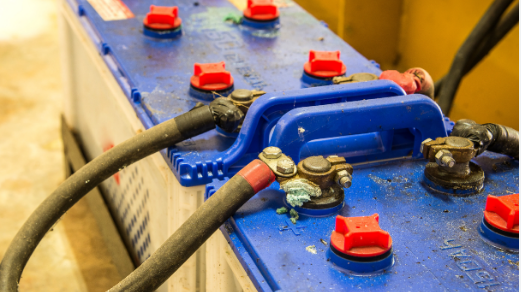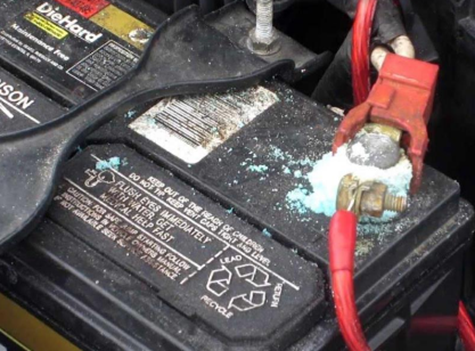Table of Contents
ToggleWhat Is Battery Acid?
Battery acid is a highly corrosive and reactive liquid found in lead-acid batteries. It is a crucial part of lead-acid batteries used in cars and electrical appliances.
Battery acid, or sulfuric acid (H2SO4), is majorly made up of sulfuric acid diluted in water to achieve the right concentration based on the lead battery type. Typically, lead-acid batteries comprise 30-50% sulfuric acid, 50-70% water, and a pH of 0.8.
Sulfuric acid in water releases a high amount of hydrogen ions, which are responsible for the low pH and highly acidic nature of battery acid. In terms of functionality, the acidic system helps convert chemical energy to electrical energy.
Also, battery acid allows for the discharge and storage of energy. It is highly corrosive and can lead to severe burns and other medical conditions if in contact with the body. Therefore, handling with caution is necessary to prevent hazards and exposure.
What Is the Ph of Battery Acid?
The pH value of battery acid is usually around 0.8. When diluted in water, battery acid completely dissociates and releases a high amount of hydrogen. This means that battery acid is highly acidic in nature.
The highly acidic nature of battery acid is crucial to the functionality of lead-acid batteries. For the charging and discharging processes to happen in a lead-acid battery, electrochemical reactions must occur, which are triggered by the high presence of hydrogen in the battery acid use.
Also, the low PH value (high acidic value) of battery acids is necessary for the conversion of lead compounds on the electrodes needed for the storage and release of electrical charges.
What Is The Concentration Of Battery Acid In Lead-Acid Batteries?
The concentration of battery acid in a lead-acid battery means how much battery acid is present in the battery. In most lead batteries, the concentration of battery acid ranges from 29% to 32%, or 4.2 to 5.0 mol/L.
Another way to represent the concentration of acid battery in a lead-acid battery is the specific gravity, with a higher value representing a more pronounced presence of battery acid. For example, a fully charged lead-acid battery typically has a specific gravity of 1.280, which is equivalent to a 32% concentration of battery acid.
Functions of Battery Acid in a Lead-Acid Battery
Battery acid performs several functions in the chemistry of lead-acid batteries. Here are the key functions of battery acid:
Electrolyte
The most significant purpose of battery acid in lead-acid batteries is the provision of a medium for the flow of ions between the battery’s electrodes, also known as electrolyte.
Electrolytes are necessary for the chemical reactions needed for the charging and discharging processes in lead-acid batteries.
Ion Carrier
For electric current to flow from a battery, there must be a transfer of charged ions between the positive and negative anodes. Thanks to battery acid, this is possible in lead-acid batteries.
Acidic Environment
Due to the high concentration of battery acid, lead compounds are converted into lead dioxide on the positive electrode, while lead compound is converted to lead sulfate on the negative electrode.
Density and Specific Gravity
Another way battery acid is important to the chemical formation of lead batteries is in the determination of the battery’s charge status and overall health. The presence of sulfuric acid in lead batteries reflects on the specific density of the battery used in determining the battery’s overall health.
Promote Heat Distribution
During chemical reactions, a high amount of heat energy is generated. Battery acids are needed to prevent damage and overheating and enable even distribution of heat in the battery.
Diagnosis
Sulfuric acid is slightly yellow with a high density and gravity. The slightest change in any of the above parameters may indicate a serious problem with the battery. This makes battery acid important for diagnosing and maintaining the battery’s health.
Check this EV Battery Test System to test your lead-acid car battery.
Reaction Principle of Lead-Acid Battery
Chemical reactions occur during the charging and discharging process of lead-acid batteries, and the reactions are the inverse of each other.
When the battery is discharging, oxidation occurs, and the lead dioxide combines with the battery acid electrolyte to produce sulfate (PbSO4) and water (H2O). Similarly, the pure lead on the anode reacts with sulfate ions to form lead sulfate. With this, the battery converts electrical energy into chemical energy to charge the battery.
During the discharging process, the battery undergoes a reverse reaction. The charging process triggers the lead sulfate on both the anode and cathode to react with the battery acid electrolyte. This ultimately results in the conversion of chemical energy into electrical energy to power the device connected to the battery.
Summing things up, the charging and discharging process ensures a lead-acid battery can store and deliver electrical energy and power compatible devices.
How Does Battery Acid Smell?
Battery acid is known for its characteristic sharp but pungent smell, similar to the smell of a rotten egg. The smell is hard to miss. The ability to identify the smell is important in the event of leakage or spillage so as to minimize hazards and ensure adequate safety precautions.
Why Does Battery Acid Smell?
Leakage, spillage, overheating, aging, and other conditions are some of the reasons battery acid smells. Here are common reasons why battery acid smells:
Leakage: Cracked or faulty batteries with broken seals are the most common cause of battery acid smells. When this happens, sulfur is released into the air.
Overcharging: Overcharging can cause electrolytes to deteriorate, leading to an emission of rotten, pungent sulfur gas. In other situations, hydrogen sulfide gas, a member of the sulfur family, is produced as a result of overcharging.
Battery Ageing: Lead batteries with worn-out bodies or weak cases are at risk of emitting sulfide gas. This is because as batteries become older, they break down from overuse.
What Neutralizes Battery Acid
As mentioned earlier, battery acid is highly acidic and can be harmful to humans and the environment. Hence, it is important to neutralize it when it becomes a threat.
The most common method of neutralizing battery acid is to add baking soda. Baking soda (sodium bicarbonate) is highly effective in neutralizing and suppressing the harmful effects of battery acid.
When baking soda (NaHCO3) comes in contact with sulfuric acid, it forms carbon dioxide gas (CO2) and water (H2O), a neutral solution.
However, it is important to note that the amount of baking soda needed to neutralize sulfuric acid depends on the amount of battery acid to neutralize or the degree of neutralization aimed. Neutralizing battery acid with the right amount of baking soda ensures the acid is completely neutralized and causes no hazard.
How to Handle Battery Acid Leaks or Spills
Handling battery acid leaks or spill risk is simple. However, it could lead to a bigger disaster if proper preventive or protective measures are not put in place. Below is a detailed guideline on how to handle battery acid leaks or spills.
Safety First
Safety is important, and safety is paramount. Protect yourself and wear personal protective equipment such as overalls, safety goggles, face masks, boots, and gloves to disallow contact.
Neutralize the Battery Acid
Sodium bicarbonate, also known as baking soda, is the most common household product used for neutralizing acids. Apply generously over the leakage or spill. To be sure that neutralization is taking place, there will be a chemical reaction between baking soda and battery acid that produces a whitish, foamy, and bubbly substance.
Clean Up the Neutralized Materials
After acid neutralization, non-absorbent materials should be used to soak up the neutralized acid. Do not use absorbent materials like tissue paper or lightweight clothes to prevent the risk of over-saturation and messy cleanup.
Dispose Absorbent Materials
Properly dispose of all materials that were used to absorb the neutralized acid. For safety, we recommend waste disposal bags designed to store chemicals or wastes.
Clean the Affected Area Thoroughly
Once the absorbent materials have been disposed of, clean the affected area thoroughly with detergent and water. Repeat as many times as possible until satisfied. Finally, use a clean and dry towel to dry off.
Proper disposal of materials
Following standard waste disposal regulations for hazardous materials, dispose of all items used to handle the leak.
Observe For Lingering Signs
Observe the area(s) keenly where the leakage or spillage occurred for signs of further leakages. Examples include discoloration, smoke, or the persistence of a pungent smell. In serious situations, it may be best to contact health inspectors and officials to protect humans and the environment.
Inform Relevant Authorities
Regardless of where the leakage occurred, it is important to inform relevant authorities. This will help prevent a recurrence or an escalation of the situation.
Final Thoughts
Battery acid is an important constituent of lead-acid batteries and is responsible for the conversion of chemical energy to electrical energy. In addition, it is needed to maintain electrical currents.
Often, battery acid may smell, and this is indicative of a leakage, spill, overcharging, or battery aging. Identifying battery acid smell helps in early diagnosis and prevention of hazards.
When handling battery acid spills or leaks, it’s important to know that battery acids are highly reactive and corrosive substances with serious medical and environmental implications if not handled properly.
We recommend following strict guidelines in handling any battery acids and informing local authorities for better control.
Check our Battery Park Test System and contact us for your battery solutions.



